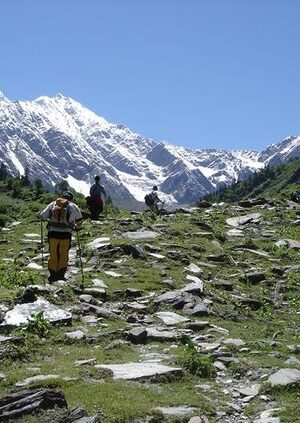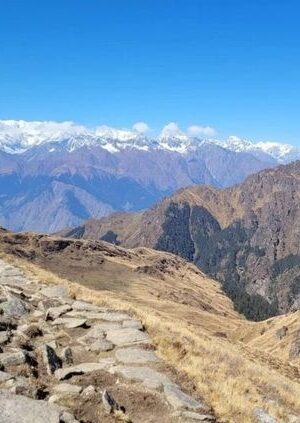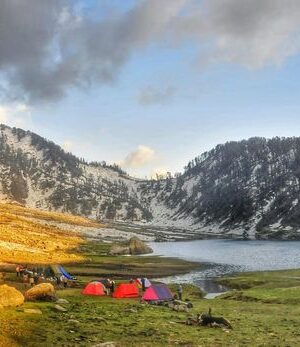Roopkund Trek also known as the Mystery Lake Trek is one of the most exciting and famous trek in the Indian Himalayas. Roopkund Lake is in the Chamoli district of Uttarakhand and is famous for human like skeletons discovered at the shores of the lake bodies are about 9th century. The scenery is just breathtaking and the experience has a sense of adventure, of the unknown, and that makes it one of the best, if not the best trekking experience.
Overview
Location: In light of the above discussions, the Chamoli district of Uttarakhand in India
Duration: 8-9 days
Altitude: About 16000ft / 4986m at Roopkund Lake
Difficulty Level: Actually, it falls between moderate and difficult as the hint suggest, Mykolas.
Best Time to Visit: the pleasant months are May to June and then September through to October.
Starting Point: Lohajung
Important Information of Roopkund Trek
Mystery of Roopkund Lake
The mystery behind Roopkund Lake also famous as the Skeleton Lake as human skeletons can be seen there. These remains are said to be of the pilgrims who were caught in a storm of hail in the course part of 9th century. It stays frozen for most part of the years and therefore the environment is more fitting for horror movies.
Stunning Himalayan Views
The roopkund trek also provides grand views of other great Himalayan giants like Trishul, Nanda Ghunti and Chaukhamba. Standing tall and white, these mountains are one of the delights of this tour through the region, especially the sight.
Diverse Landscapes
This hiking trail passes through regions with oak and rhododendron trees, meadows which are called ‘Bugyals’ here and rocks. Thus, worrying about the monotony of the roopkund trek; every segment of the trek is filled with a particular kind of beauty.
High-Altitude Meadows
Along the route, it covers Ali Bugyal and Bedni Bugyal, two of the largest alpine pastures in Asia. These Bugyals are available in green colour during the pre- monsoon season, while these turns into the golden colour during the post monsoon season.
Sacred Sites
The tour also takes the visitors to the important religious places like the Bedni Kund, is the pilgrimage site which is worshipped by the locals and trekkers and the Nanda Devi temple which is one of the holiest shrines for the locals.
Camping Experiences
The trekkers get the opportunity to camp in the wonderful campsites present on the Roopkund Trek, where the trekkers can camp directly under the sky exposed to the celestonal beauty of the Himalayas.
Best Time to Visit Roopkund Trek
It is recommended to take the Roopkund Trek in the months of May and June, and September and October. These two seasons are characterized with stable weather conditions and ease in accessing the trail since there is no snow. From May to June the meadows are green and the climate is comparatively moderate and charming, however from September to October the weather is extremely clear with crystal touch sky and snow clad mountains.
What to Pack
Clothing: Clothing in layers to retain heat in cold and to shed excess heat in hot environment. This should comprise thermal wear, fleece jackets, waterproof jackets, trekking pants, gloves, woolen caps and extra socks.
Footwear: This is particularly important, since it is rather wet, snowy, and rough in the parts of Himalayas – proper waterproof trekking boots must be worn, as well as comfortable socks.
Gear: Cane or walking stick, a good strong rucksack, a warm sleeping bag, a good quality headlamp or torch with spare batteries and cover for rucksack.
Personal Items: Towel/drying stuff, sunglasses, sunscreen, water bottle or hydration backpack, necessary medications, injuries medication kit, and toilet necessities.
Documents: Make sure you have proper identification and where necessary, permit for the trekking this can be gotten through trekking companies.
Physical Preparation
Trek to Roopkund is moderate and one needs to be comparatively fit to undertake this trek during May and June. Here are some tips to prepare:Here are some tips to prepare:
Cardio Exercises: Aerobic exercises like running, cycling, or swimming should be taken in order to increase the stamina.
Strength Training: Concentrate on the leg workouts that include squats, lunges, step-ups, etc. General weight-bearing exercises also will be helpful while the core strength will also be nice.
Hiking Practice: In as much as it is possible, seek to do the hike riding an actual backpack with the paraphernalia just like in trekking. Progressively, the weight that you take with you and how many hours you spend on those hikes should also increase.
Cultural Experience
The Roopkund Trek also has a provision for an up close and personal experience with the Garhwali people’s way of life. During the trek and while approaching the villages, people can get an idea of they’re customs, agricultural practices, and even their food habits. Besides, the friendly temperament of the local people endues the trekking journey with a unique cultural flavor.
Environmental Responsibility
Practicing Leave No Trace principles is crucial to preserve the pristine environment of the Himalayas.
Carry Out All Trash: Ensure that you do not make a mess behind you. Always have a bag, small but enough to carry all your litter and when you are back to the mainstream society, properly dispose it.
Stay on the Trail: This is because although the paths are very obvious, they are destructive to the sensitive soil and vegetation.
Respect Wildlife: Do not be a part of the experience you are witnessing from close quarters and at the same time, do not harm or intrude the comfort zone of the animals. Wild animals should not be feed or provoked in anyway.
Use Biodegradable Products: Also avoid washing utensils and clothes using colored soap, instead wash with biodegradable soap, and avoid using extraordinary toiletries.
Local Flora and Fauna
The flora and fauna found in Roopkund Trek are very appealing to the eyes. The oak and rhododendron forest provides the habitats for many birds such as the woodpeckers, sparrows and the thrushes. The spring season brings beautiful wild flowers on the alpine meadows and in the winter season the same meadows are covered with snow. It is also possible to see such animals as Himalayan tahr, musk deer, and if the luck is on your side – the Snow Leopard.
Why Choose Roopkund Trek?
Accessibility: The roopkund trek is nearly approachable form major cities like Delhi that makes it favorable for many trekkers.
Moderate to Difficult Challenge: It is appropriate for those good trekkers, those who want to start with the treks for beginners or those who are up for a challenge.
Scenic Beauty: With its hilly country, the trek covers a lot of terrains for the trekkers including, forest areas, fields, plains, lakes among others.
Mystery and Adventure: The historical as well as the mysterious nature of the Roopkund trek place makes the trek quite interesting.
Conclusion
Roopkund trek is an adventurous trek with natural beauty and trekker gets the feel of something mysterious around. It is a classic trek that offers wonderful view of the Himalayas, geographical diversities and tough trial; therefore it is perfect for the experienced trekkers who would want to make their trip memorable. If done correctly with due regard to the environment on the path, the trek taken in one of India’s most mystic and scenic territories will prove to be both safe and fulfilling. Happy trekking!
Itinerary
Day 1: Getting to Lohajung
Travel: Road Travel from Rishikesh/Kathgodam to Lohajung (Round 200kms/ 10-11 hrs).
Accommodation: Guesthouse in Lohajung.
Highlights: Drive through the Kumaon region mainly driving across Almora and also Kausani or any other place. Stay in a simple and beautiful village – Lohajung.
Day 2: Lohajung village to Didna village
Trek: Trekking from Lohajung to Didna Village will take about 6 to 7 hours normally.
Accommodation: In this case it could be taking homestay accommodation or camping at Didna Village.
Highlights: Beginning with an easy portion with crossing over Neel Ganga River, the next phase includes steep climb through the oak/rhododendron zone. See the life of the natives as well as the tamed landscape of terraced fields here.
Day 3: Didna Village to Ali Bugyal
Trek: Trek from Didna Village up to Ali Bugyal takes about 6-7 hours.
Accommodation: Again I took my camera and my hiking boots and I go high up in the hills to spend a few days of camping near Ali Bugyal.
Highlights: From there the trail goes slowly and steadily and enters deep forests and emerges into the grassy meadows of Ali Bugyal with the views of the snow clad peaks and the green carpet of the meadow.
Day 4: Ali Bugyal to Ghora Lotani
Trek: Trek from Ali Bugyal to Ghora Lotani which should take approximately 4-5 hours.
Accommodation: One of the activities that can be done from S Dust is to have a camping at Ghora Lotani.
Highlights: It carries on further up to the Hodgson’s country of Ali Bugyal to Ghora Lotani via Chauli Ki Gali. This day is relatively easier than the other days and provides majestic views of the Himalayas in the distance.
Day 5: Ghora Lotani to Bhagwabasa through Kalu Vinayak
Trek: 5-6 hrs trek from Ghora Lotani to Bhagwabasa passing through Kalu Vinayak.
Accommodation: Camping at Bhagwabasa.
Highlights: In this part of the trek, there is some some climbing up to the Kalu Vinayak shrine and then some rasying down to Bhagwabasa. The mountain Kalu Vinayak is very beautiful and has splendid view of Mt. Trishul and other terminating hills.
Day 6: Union of Bhagwabasa to Roopkund Summit, returning back at Patar Nachauni
Trek: 15-16 hours full day trek from Bhagwabasa to Roopkund Summit and to Patar Nachauni village.
Accommodation: Taking up a night’s tent in Patar Nachauni.
Highlights: This is the day I have been waiting to climb this mountain and at long last, this is the day. The track to Roopkund is strenuous and includes the elements of trekking on the snowy tract as well as the rocky one. Just arriving at the beautiful Roopkund Lake located at 5000 meters is something big for the trekker. After a while, drive back to Patar Nachauni to spend the night there.
Day 7: Patar Nachauni to Lohajung via Bedni Bugyal and Wan Village
Trek: Wan Village from Patar Nachauni is a trek of about 7-8 hours including Bedni Bugyal.
Travel: Again begin to trek from Wan Village to Lohajung by Jeeps.
Accommodation: Guesthouse in Lohajung.
Highlights:
Bedni Bugyal: From here it goes down to the picturesque meadows of Bedni Bugyal, stretch of green that offers stunning views of nearby mountains.
Wan Village: Carry on with the flight through the woods and the fields to Wan Zhai. Wan is the final point of the trek where a drop back to Lohajung is arranged after a tiring day of trekking.
Drive to Lohajung: Once you get to Wan Village, by car it will only take you a few minutes to get back to Lohajung. Take an accommodation in a guest house and think about the impressions from the treks.
Day 8: Leaving the starting point of Lohajung
Travel: Proceed back to Rishikesh or Kathgodam (it will take nearly about 10-11 hrs drive).
Highlights: Retrogressive drive commenting on the trekking exercise. Get through picturesque scenery and through countryside, villages and cities where tasty snacks and local food can be tasted.
End of Trek: When you get to the destination, end the trek with happy feelings of the Roopkund Trek you had all along.
Meals
Healthy, nutritious vegetarian meals for all meal cycles for eight days, including snacks, tea, and coffee, and three meals a day.




Reviews
There are no reviews yet.